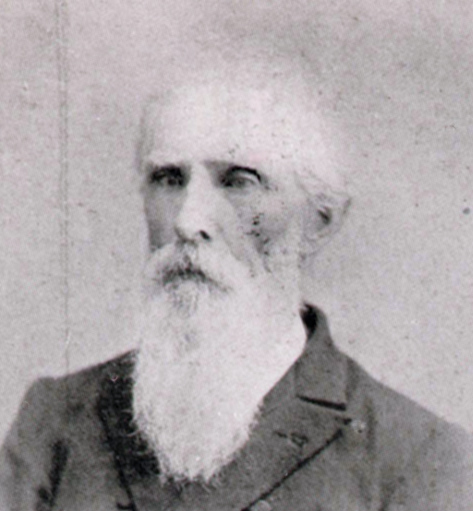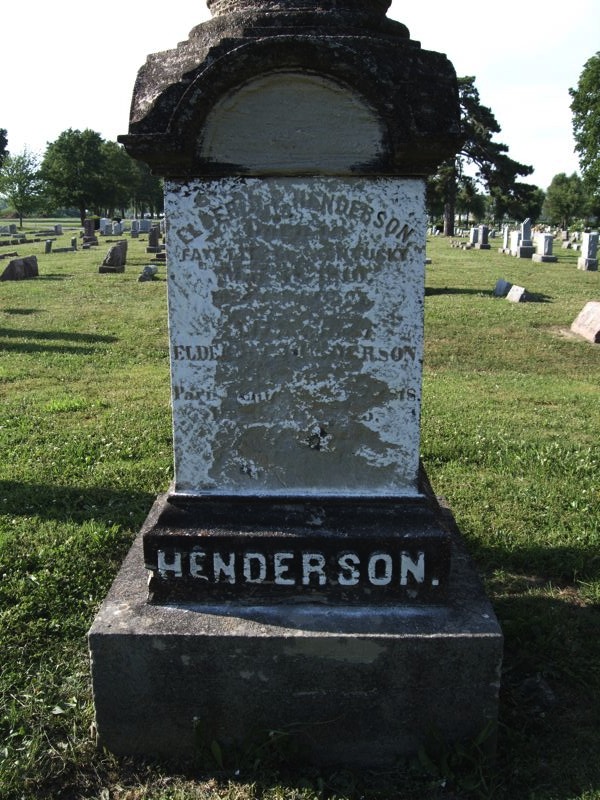David Patterson Henderson
1810-1897
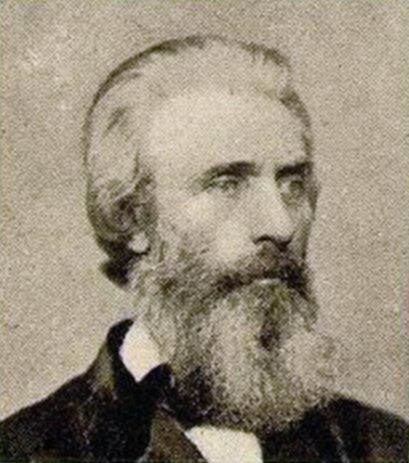
Table On Contents
A Look At The Life Of D. Pat Henderson
The Cause In Chicago, The Gospel Echo, 1867
Correspondence From D. Pat Henderson
A Chronology Of The Life Of D. P. Henderson
Location Of The Grave of D.P. Henderson
Grave Photos
Special Thanks
A Look At The Life Of D. Pat Henderson
The early part of the 19th century saw the first great generation of reformers involved in promoting a restoration of the ancient order of things. Barton W. Stone, Thomas and Alexander Campbell, and Walter Scott were among the first generation of leaders who introduced many in North America to first century Christianity. May of 1810 was a significant month in the introduction into the world of two future leaders of the second generation of restoration leaders. The first was born in Tennessee, and the second in Kentucky. As the former greatly influenced churches of the south, the later influenced churches of the north. Tolbert Fanning was born May 10th. Eight days later David Patterson Henderson was born in Fayette County, Kentucky.

courtesy of Jim McMillan - 11.2012
Northern Kentucky was a hotbed of restoration during Henderson’s formidable years. It was New Years of his twenty-second year when the Reformed Baptists in and around Lexington, under the leadership of John Smith, united with the Christians under the guidance of Barton W. Stone. The following July 5th, D. Pat Henderson responded to the preaching of the gospel and was baptized by Stone in the North Elkhorn at Prewitt’s Mill. A friendship immediately developed between the two men that continued for the rest of the senior church leader’s life.
D. Pat Henderson was educated in the study of law. He served as a lawyer for many years. However, his greatest love was the gospel, and the preaching of it. It was said that D.P. Henderson’s “silvery voice and magnetic personality made him a power in the pulpit, and a man among men,” (The Story of the Century, p.183.)
By 1834, many in the area of Fayette and Scott Counties, Kentucky caught the fever to move further west. B.W. Stone made trips into the western region of Illinois and determined to remove to that area. In the fall of the year the Stones moved to Jacksonville, Illinois. The Henderson family followed suite moving into the same area.
Upon arrival in Morgan County, Illinois, D. Pat opened a law practice in the city. It was not long before he became clerk of the court, and was connected to other great lawmakers in the area. For at least four years he served on the bench as Probate Judge. A fellow Kentuckian, just a year his senior, working in the same field, and just a few miles to the east in the state capital city of Springfield, was none other than Abraham Lincoln. Henderson claimed that Lincoln practiced law in his court.
Since the early 1820’s the Christian Messenger was a mainstay among churches in Kentucky. After the 1832 union at Lexington, John T. Johnson, a leader among the disciples, began co-editing the paper with its founder, and continued to do so until Stone’s departure to Illinois. With the move the publishing the Christian Messenger was spasmodic, and was not produced at all between 1836 and 1839 due to paper shortages. In 1840 the journal began again with the assistance of T.M. Allen and Jacob Creath, Jr. of Missouri. Then in May, 1843, D. Pat Henderson was announced as Barton W. Stone’s Co-editor.
The year after settling in the west, with Henderson’s law practice underwriting his financial needs, he was free to devote the weekends to evangelism. He worked in the villages and countryside preaching and teaching with great success. He planted a congregation about seven miles east of Jacksonville in a community primarily made up of immigrants from his home in Kentucky. The church was called Antioch.
He continued to preach among the neighborhoods of Morgan County, but occasionally would make preaching trips abroad. On August 1st, 1836, while on a preaching tour back in his home state of Kentucky, one young man in the crowd responded to the gospel invitation. They soon removed to the baptizing pool where he baptized the young fourteen year old Winthrop Hartly Hopson for the remission of his sins.
On January 17, 1837 he married Miss Eliza Smedley of Paris, Kentucky. Barton W. Stone conducted the wedding in Jacksonville. Throughout the year his field of evangelism took him as far as the District of Columbia and Baltimore where he planted churches that maintained strength for many years. Even thirty years later when he visited the area again to hold meetings, he refreshed to see that some whom he converted those many years previous were still among the brethren.
By 1841 D.P. Henderson’s influence was being felt as far north as Chicago. For a time he was the main evangelist among the brethren in that city. According to historian N.S. Haynes, “T. T. Holton says of him: 'He was a model of grace for an old man and very winning and persuasive in his address. I think in his youth he could have courted a princess. He was a man of wonderful energy, though slight of build.'" (History of the Disciples in Illinois, p.529). However, during the early 40’s his main evangelistic effort was in Western Illinois.
In early November, 1844, the news came to Jacksonville of the passing of Barton W. Stone while at the home of his daughter in Hannibal, Missouri. Within days memorial services began taking place in different cities. D. Pat Henderson conducted the memorial service that was held at Carlisle, Kentucky. Stone was buried on his property, just south of town, but would later be moved to Antioch, and then to Caneridge, Kentucky years later. As had already been pre-arranged, D.P. Henderson was the executor of the will. But, his greatest challenge was what to do with the Christian Messenger. He became the editor of the paper, writing of his desire to serve in what capacity he could. He admonished the brotherhood to remember the widow that was left behind. Under his editorship, the paper only continued through to the April issue of the following year. This was not the end of his editorial work. For a time in the late 1850s he and Dr. James Shannon edited the Christian Evangelist, a Christian journal that had been published in Fort Madison, Iowa.
D. Pat Henderson was not only successful as a preacher and a writer, but he also believed in the education of young people, especially young women. In 1847 when a school was being considered for girls in Eureka, Illinois, he was one of its strongest advocates. The brethren in Eureka were beholding to Henderson for his help, not only for education but also for outreach. He held a protracted meeting at the Walnut Grove church in the early fall of 1848 and after preaching many days over one hundred people had been baptized, (History of Eureka College, p.19).
Later in the fall of the year the Hendersons moved to Columbia, Missouri to begin what would ultimately be a five year commitment with the First Christian Church in that city. Henderson’s interest in the education of young women was soon to be felt. In 1851, along with T. M. Allen, James S. Rollins, William F. Switzler, Dr. William Jewell, Robert S. Thomas, he was able to greatly help to bring about the new Columbia Classical Female Institute. (Tracing Our Steps, J.T. Smithson III, p.87). Very soon thereafter, the need for a co-educational institute was in desperate need in the area. On December 4, 1851 a board of trustees was organized, and D.P. Henderson served as president, an office he held until 1865. Application for charter was made to the Missouri State Legislature, and was granted it in January, 1853. In 1852 he proposed to the city of Canton, Missouri the need for a co-educational facility in their town. The college was planted as Christian College. It held that name until 1908 when the name was changed to Culver-Stockton College. Within six years of his death in 1897, the main hall of the school burned to the ground. A new building was commissioned and called appropriately, Henderson Hall.
During the early to mid-1850s the Henderson family moved to the gateway city to the west. He had already made trips into the city of St. Louis as early as in March of 1842 when the church was reorganized there and meeting in the home of Robert B. Fife. D. Pat had made further trips there in 1842 and 1844. (History of the Churches of Missouri, p.27).
In October, 1855 the door of opportunity had been opened at Louisville, Kentucky. He moved his family to that city and began evangelizing. In the 1856 volume of the Millennial Harbinger, Alexander Campbell recalled from a visit there, “The increase of the Christian church in that city, under the labors of Elder D. P. Henderson, during the last year, has been unprecedented in that city: some 500 additions have been added in little more than a year, and during our stay, it was still growing in numbers.” Within a short time it was essential to build a building and it culminated with the erecting of, “the great pillared Temple at the corner of Fourth and Walnut Streets.” (Haynes, p.529).
Though primarily dedicated to the work in Louisville, his ministry took him to other places as well. When Alexander Campbell visited the south for the purpose of endowing the college at Bethany in 1857, his travels led him to New Orleans, Louisiana. It was there that he came in contact with D. Pat and Dr. James Shannon, and together worked to reconstitute the congregation there.
During the war between the States, D.P. Henderson held strong convictions for the Union cause. However, living in a border state, he displayed a since of deference with those who held equally strong opposing convictions. Though he had been among those who formally condemned the South during the annual meeting of the American Christian Missionary in the fall of 1861, he maintained a spirit of love and commitment to those on both sides. He conducted a daily prayer meetings in the basement of the church building at Fourth & Walnut Street in hopes of a quick end to the hostilities.
After the end of the war, freedom to travel, and the call of need for the gospel caused him to depart to other places. One of his first calls was the Indiana State Missionary Society meeting in the summer of 1866. When W.K. Pendleton reported on the meeting in the pages of the Millennial Harbinger, he said of Henderson’s preaching, “In the evening we had a cheering discourse from Bro. D. P. Henderson. He fascinates his audience by his exuberant electricity. His power is in his presence. It goes out from him like an aura. He holds one, like a magnet holds a needle. He spoke from the 2nd of Acts, and the controlling thought of his discourse was the Missionary character of the church, as exhibited in the first and original church at Jerusalem,” (MH, 1866, p.524).
In November, 1866 he departed Louisville after eleven years of service for his beloved Springfield, Illinois. His work in Louisville was summarized by W.T. Moore,
"While the Disciples were passing through this transitional period, where they were reaching out for organization and co-operation, they did not cease their evangelistic efforts.
"Some great meetings were held about this time, and among these may be mentioned one that was held with the Fourth and Walnut Street Christian Church in Louisville, Ky. D. P. Henderson . . . was the chief preacher at this meeting. The remarkable character of the meeting was in its continuation for months, and in the simplicity of the methods adopted. Henderson's style was very unique. Nearly all the time he was speaking he held the Bible in one hand, and slightly gestured with the other. He did not quote the Scriptures as preachers usually do, but he read nearly every passage out of the Bible itself, so as to be exact in all the quotations he made. His discourses were, as a rule, simply running comments upon the Scripture used, and were without rhetorical finish, and frequently with no logical sequence. Very often each discourse would be a commentary on several selected passages of Scripture, and not infrequently a whole chapter would be brought into requisition as the basis of what he had to say.
"From week to week he kept up the interest by this simple style of preaching, and the result was a great ingathering of souls. He continued to be the pastor of the church for some time after this great meeting, and did much to plant the cause firmly in the city. (A Comprehensive History of the Disciples Of Christ, W.T. Moore)."
By 1868 he was in Chicago helping the Sixteenth Street church in the planting of a new work at the Orphan Asylum building on Michigan Avenue. (Churches of Christ, John T. Brown, p.300). According to N.S. Haynes the church had divided in 1869, and about forty left under the preaching of D.P. Henderson, (History of the Disciples Of Christ in Illinois, p.152).
Around the turn of the following decade, D. Pat answered the call to come and help in St. Louis, Missouri. The Central church in St. Louis had met for the first time in December, 1871. This congregation came about as a result of a division that had taken place at the First Church when a group of members had unsuccessfully attempted to introduce instrumental music into the worship. As a result twelve members departed and began meeting in a public hall at Fourteenth and St. Charles streets. D. Pat Henderson served as their first minister, but for only a short time.
The Hendersons then moved to Canton, Missouri and continued in the work of evangelizing, and helping the college there as best he could. Now in his 60’s D. Pat was intent on helping in the work where the Lord saw fit. On a sad note, while living in Canton the bride of his youth, Eliza passed away January 7, 1875. The couple were childless.
As the Henderson never had children, the last years of Henderson’s life were spent in the home of an adopted daughter, Mrs. E.F. Henderson, a daughter of his friend W.E. Johnson. In his 87th year he passed from this life February 11, 1897. His body was removed to Jacksonville, Illinois where his parents, and wife and sister were buried. A funeral in the city of Jacksonville took place on the 14th with Dr. S.B. Moore conducting the service. He was buried in Diamond Grove Cemetery to await the coming of the Lord.
-Scott Harp
The Cause In Chicago - An Editorial
We are perhaps all sensible of the great importance of firmly planting the cause of the Lord in this great commercial center, which has sprung up as by magic. Take Chicago in all its bearings—its rapid growth, advantages from lake navigation, its almost boundless network of railroads, its geographical position and the indomitable energy and perseverance of its business men, and no parallel can be found on this rolling ball. Within her borders may be found representatives of the nationalities of the civilized world, and every shade of sectarianism in religion has its altar and [455] its priest; from the papal imposition down through the long progeny of pompous daughters, to that last and most abominable delusion called modern spiritualism. Merciful father! What a motly [sic ‘motley’] crew. How little is known of Apostolic Christianity in this babbling city!
But we sat down to write a line in regard to the present condition and future prospects of the Church of Christ in Chicago. The brethren are the owners of a fine and commodious house of worship, situated on Cass St., three blocks north of State St. Bridge, known as the "Old St. James’ Episcopal Church." Brethren on business in the city, will find the place of worship within short walking distance of the Hotels. The house seats, in comfort, 600 or 700 persons.
Bro. D. Pat Henderson, for so many years the loved and successful resident preacher at Louisville, Ky., is now settled with the church in Chicago, and we learn from an authentic source, that weekly additions are being made to the congregation of the Lord. We know of no man, who in our judgment, would accomplish more in this surging, heaving tide of humanity, than Bro. Henderson. He is an able, earnest, industrious and unusually successful preacher of the pure gospel of Christ, as found on the pages of God’s own Book. Even now as we pen these lines, the remembrance of having heard him a hundred times, creates anew, the desire to hear his peculiarly persuasive voice once more, which we trust we shall yet do. Bro. Henderson accomplished a work in Louisville, in 1855, in the brief space of two or three months, which has no parallel in the history of this Reformation, or of modern times. It was our lot to be present during a part of that effort, and certainly think we never saw a man more fully clad in the power and armor of truth than was he; and victory, glorious and triumphant victory, came as the result. We expect much from Bro. Henderson’s labors in Chicago, if the brethren stand by him with their united prayers and co-operation.
In speaking of the Louisville meeting, we are reminded that there we saw and enjoyed the society of two noble veterans, whom we shall see no more, till we pass under the rainbow and reach the "Sunny Side," whither they have gone. We allude to the erudite, genial, aimable [sic ‘amiable’] and devotional Walter Scott, and the loved and loving John T. Johnson. These two successful preachers now rest from their toils. There too, we saw for the last time the devoted Curtis J. Smith, who yet lives, though somewhat advanced in years. Time with all will soon close, when eternal joys will be ours.
-Gospel Echo, 1867, pages 454, 455., contributed by James L. McMillan, 04.28.2014
Correspondence
Reminiscences
Dear Standard – I am going home, once more, to spend my days on earth among those I left fifteen years ago. Twelve eventful and successful years were spent in Louisville, Ky. Five years and upwards, never was a pastor, never was a people, more highly blessed. More than two hundred happy converts were added to the Church, corner of Fourth and Walnut Street, within the months of May, June and July, 1855. I spent August, September and October, in Canton, Mo., assisting in the erection of our present commodious church edifice in that beautiful town, under the shadow of ‘Christian University.’ In November, wife, daughter, and self, landed in Louisville, Ky., with the intention of spending only a single year with that congregation. The year soon fled, and the same reasons which induced me to accept their call at the first were increased and intensified, and so we spent another, and yet another, till five years were numbered with those beyond the flood. During these years I had visited New Orleans, Baton Rouge, Memphis, Lexington, Ky., and New York, and performed much labor in these cities.
In the fall of 1860, the turbulence of political party spirit caused the storm cloud of war to overcast our national horizon. I was called to Washington City for a short time, and there, from the lips of the late lamented Stephen A. Douglas, one of the great men of the nation, I learned the probable certainty of a conflict between the Southern States and the Government of the United States. It sickened my heart. I returned to Louisville filled with sorrow and anguish. In 1861 the war commenced, while I was holding an interesting meeting for Bro. J. S. Lamar, in Augusta, Ga. I shall never forget the pleasant conversations I had with that devout, pious, intelligent Christian brother. He and I were the first in Augusta to whom was communicated startling and painful intelligence of the attack on Fort Sumter. The railroad superintendent communicated it to us. For a while we stood speechless. Bro. Lamar, as he sketches these hasty lines, will recall not only that painful morning, but remember many other days we so fraternally and confidentially spent together. We had a good meeting, added quite a number to the Church, and left, I think, on or about the last through train, with a letter from the Hon. J. P. King, of Georgia. On our return to Louisville, we found all in excitement—the storm gathering strength from the excited elements every where. Many of my brethren appealed to me to remain with them. I promised to do so, and do so I did, under good as well as evil report. In May, 1861, I commenced a morning prayer meeting at the Church, and for three years and about seven months, we met every morning for prayer. This prayer meeting did us all great good. My mind turned almost instinctively to the subject, what is my duty to the Government? The duty of one Christian is the duty of all Christians. This was self-evident. The more I read, the more I prayed, the longer I meditated, the more plainly did I read my duty and that of my brethren, to ‘obey the magistrates, and to be ready for every good work.’ My religion, as well as my patriotism, determined my course, regardless of all partisan politics. I commenced a series of discourses forthwith on the subject, and continued them for many years during the conflict. Of course, I had to suffer in the estimation of those who were bent on the destruction of the Government. But the Church kept together; we lived in peace, unity, and prosperity, with few exceptions. We accepted the unity of the faith, and held our opinions as private property. We sunk every thing out of view for Christ and his cause. God blessed us. Almost every Lord’s day we had some to immerse. Indeed, such was the history of the Church for ten years. The troubles and trials of the country threw many brethren from other localities into our midst, who brought with them peculiar views on many subjects. Hitherto we had preached Christ crucified to sinners, Christ raised and glorified, to our brethren, and loved one another with pure hearts, fervently, discarding speculations entirely. With the political disaffection of a few, and the bringing in of questions of Church government—the power of the eldership, the duty of the deacons alone to attend to all the finances of the Church—a great change of feeling soon became manifest. I thought the time had now arrived for me to notify the Church that, as I had been called unanimously by them to be their pastor, and had always told them I would never be a pastor of a divided membership, I would never permit myself to be a candidate and voted for and against by my brethren for any place in the Church. I, therefore, as soon as the financial year expired, retired from my long pastoral labors with that people.
I was appointed evangelist of the church, and spent several months of the time in the city of Washington, assisting the few brethren there. My labors were, to some extent, quite successful, and I have the satisfaction to know, I have contributed to some good degree in more firmly establishing Christianity in the nation’s capital.
On my return from my labors in Washington, Illinois and Missouri, to Louisville, Ky., I preached my last discourse to one of the largest audiences ever assembled in their place of worship. Without distinction of party or difference of opinion, I received from that dear congregation as strong evidence of pure Christian love as was ever manifested to me in all my life.
Chicago unanimously called me to the oversight of the small congregation that worshiped in this great city. I came, labored for them eight months, was satisfied that I neither suited them nor did they suit me; that it was best to resign and go to work in another part of the city. I told them so kindly and plainly, and urged them to accept my resignation with the same unanimity with which they called me. My resignation was accepted, and I immediately set to work, hired the chapel in the Orphan Asylum, on Michigan Avenue near Twenty-second street, in which I at first preached to a very small, select audience. Announcement was made that on the following Lord’s day as many as desired to form a congregation would come prepared to enroll their names. Publication was made in the city papers of the meeting and its object. A much larger audience assembled, and thirty-nine Christians enrolled their names, faithfully promising, each to the other, and all of them to God, that they would strive to be holy, pious, prayerful, and to the best of their ability, as the Church of Christ, keep all God’s laws and Institutions faithfully while they lived.
We raised a subscription, appointed a Building Committee, let out a contract for a church edifice, and in four months and five days from the time we broke ground, we entered into it, on the 17th day of January, 1869, to be greeted by the largest audiences we had ever met in Chicago. Brethren John T. Jones and Enos Campbell, of Jacksonville, Jas. Challen, then of Davenport, Iowa, and other brethren from abroad, were with us on that pleasant, memorable day. I labored for the church till our number increased to ninety-five, and so soon as I could secure the labors of a younger man, I determined to go home to Canton.
God has sent us Bro. O. A. Burgess, who took charge last Lord’s day, under most encouraging auspices. I trust he will carry forward the good work. He is able, learned, zealous, and independent. May God bless him. The Church is dear to my heart, and it is painful to tear oneself away. But ‘Home, home, how sweet to a weary spirit.’ Address me at Canton, Lewis Co., Mo., about which, after a while, I will have much to say. Meantime, may the blessing of God rest upon you. Yours in Christ,
D. P. Henderson.
P. S. I have just returned from Canton, where, among others, I had the pleasure of meeting Bro. Dr. Shepard, whom I had not seen for many tedious, painful years. He was visiting Canton, enjoying the society of his many friends and admirers. We came here together, and had the pleasure of meeting Bro. A. S. Hayden, who is quite busy with his great work on music, designed for congregational singing. While so much precious time and talent are taken up with the discussion of the ‘Organ question,’ brother Hayden is hard at work on a book, which, if I judge correctly, will be immensely popular, not only among our own brethren, but will be sought for by all who love truth, melody and harmony. Messrs. Root & Cady, of Chicago, the great musical composers and publishers, are now pushing Bro. Hayden’s work to rapid completion. They have kindly showed me some proof sheets and they are not only elegant, but in large, beautiful, musical type, and the hymns corresponding in size of type and execution. The plan of the work is very much after the style of the ‘Plymouth’ Book of Church Psalmody. The hymns from our hymn book, are arranged with reference to their metres [sic], and the music is at the head of the page, so that both the music and the words are on the same page. This will be an argument, not easily refuted, in favor of good congregational music. The number of the hymn corresponding with its number in our present valuable hymn book, will be found, so that the two can be used at the same time without confusion.
Bro. Hayden has just left my room and informs me that Messrs. Root & Cady promise to have the work ready in a month. I am glad to be permitted by Bro. Hayden, to close this letter with this short and hasty reference to the forthcoming work on music. When the brethren get it, I hope the organ and anti-organists will sing themselves into a purer and holier spirit, out of this peace-offering soon to be laid on the altar of music.
D. P. H.
- D. Pat Henderson’s Reminiscences in Christian Standard, August 6, 1870, page 250
Contributed by Jim McMillan - February 14, 2019
Chronology Of The Life Of D.P. Henderson
September 21 1786
Margaret Henderson is born, the mother of DPH
November 26 1786
James Henderson is born in Lexington, Kentucky–the father of DPH
May 18 1810
David Patterson Henderson is born in Fayette County, Kentucky.
February 2 1818
Eliza Smedley is born in Paris, Kentucky, later marries DPH
March 13 1819
DPH’s sister, Eleanor is born
1831
Moved from Fayette Co., Kentucky to Jacksonville, Morgan Co. Illinois.
Early 1832
DPH returned to Georgetown, Kentucky because of illness
July 5 1832
D. Pat Henderson responded to the preaching of the gospel and was baptized by Barton W. Stone in the North Elkhorn at Prewitt’s Mill.
October 1832
DPH returns to live in Jacksonville, Illinois / The church in Jacksonville is organized by Josephus Hewitt, B.W. Stone, DPH, Enos Campbell and others. Other churches pre-date this work, but this is when union takes place between Disciples (Reformed Baptists) and Christians unite. (Journal of the Illinois State Historical Society, vol. 4, p.312)
1833
DPH organized the church at Antioch, just seven miles east of Jacksonville on the Springfield Road
November 15 1835
Letter from DPH to A. Campbell from Jacksonville of the presence of B.W. Stone, and a church building 35 by 42 feet underway. (MH, 1835, p.182)
August 1 1836
DPH baptized Winthrop Hartley Hopson at the age of 14.
January 29 1837
DPH marries Eliza Smedley of Paris, Kentucky. Barton W. Stone presides at the wedding in Jacksonville, Illinois
May 23 1837
DPH’s sister, Eleanor dies in Morgan Co. Missouri. Buried in Diamond Grove Cemetery
1840
DPH served as Probate Judge for four years in Springfield, Illinois court system. He knew another Kentuckian who often litigated in his court: Abraham Lincoln.
September 27 1840
"Annual Meeting" Held at Springfield. B. W. Stone, John T. Jones, Peter Hedenberg, D. P. Henderson, Henry D. Palmer, William Davenport, John Rigdon, D. B. Hill and Theophilus Sweet. One object of the meeting was to put "as many evangelists in the field as possible." (Hist. of Disciples of Christ in Illinois, N.S. Haynes, p.88)
1840s
DPH operated what he claimed to be the first anti-slavery paper west of the mountains, with a Professor Turner, called the Statesman. (Historic Morgan and Classic Jacksonville, by Charles Eames, p.133).
January 1843
Jacob Creath, Jr. comes to preach at Jacksonville with co-laborers, William Brown, John T. Jones, B.W. Stone and DPH. (Donan, p.135)
May 1843
DPH becomes Co-Editor with Barton W. Stone of the Christian Messenger
November 1844
Death of Barton W. Stone at Hannibal, Mo. DPH publishes Vol. 14 #7 of the Christian Messenger with Obituary and Will Executor’s appeal for unpaid dues from subscribers to pay for the purpose of helping Stone’s widow and family.
April 1845
Last issue of the Christian Messenger produced under the editorship of DPH.
1847-48
DPH studies medicine at Illinois College, continues preaching during that time.
July 10 1848
Letter from T.M. Allen in Columbia, Mo, to A. Campbell, of a successful meeting with DPH in Columbia, 8 baptisms. (MH, 1848, p.703)
September 1848
DPH in a protracted in Eureka, Illinois. After “many days” over 100 baptisms. Known for many years at Eureka as the “Great Meeting of 1848.”
Fall 1848
DPH moves to Columbia, Missouri to work with First Christian Church
November 1849
“In November, 1849, Dr. Samuel Hatch and Prof. Henry White of Bacon College, Harrodsburg, Kentucky, came to Columbia with the view of inaugurating a "Female Collegiate Institute." They, in connection with Dr. Henderson and President Shannon of the -State University, successfully carried their plan into execution, and on the recommendation of Dr. Shannon, John Augustus Williams of Kentucky was elected the first president of the newly founded institution. A small house in the town was at first used, but so rapidly did the school grow a new building became necessary. The incomplete residence and twenty-nine acres of land, belonging to the estate of Dr. J. H. Bennett, were purchased in 1851, and the building was opened for the regular session in September of the same year.” (History Of Higher Education Of Women In The South Prior To 1860, by Mrs. I.M.E. Blandin, c.1909 p.208)
June 30 1949
Letter to A. Campbell, (MH, 1849, p.479) “Brother D. P. Henderson, of Columbia, and Osborne, of Jacksonville, Ill., were with us four days.” - 17 additions in Paris, Missouri
August 22 1850
DPH, with T.M. Allen and President Shannon in a meeting at Bloomfield, Callaway County, Mo. – 48 additions (MH, 1850, p.596)
January 18, 1851
The female college was chartered by an Act of the General Assembly of the State of Missouri, January 18. 1851. (Laws of Missouri, 1:51, pp. 310-312.) According to the terms of this charter James Shannon, T. B. B. Smith, Thomas M. Allen, D. P. Henderson, William McClure, W. W. Hudson, Robert S. Barr, Thomas D. Grant, Levi T. Smith, Flavel Vivian, John Jamison, W. F. Birch, J. J. Allen, J. C. Fox, Lewis Bryan, Elijah Patterson, John S. Phelps, Wayman Grow, S. S. Church, and Moses Land were to constitute a corporate body with perpetual succession. (Sec. I, P- 3 11) Also, said College shall be located at such a place within the State as shall be designated by a majority of the trustees herein named (Sec. 2.) Classes begin in September
December 15 1851
Board of Trustees formed for proposed Christian College. D.P. Henderson is elected President of the Board. Serves in this role until 1865.
April 2 1852
Memphis, Tennessee, DPH attends a Bible Union Meeting. DPH is placed on a committee to report names of officers to preside over the convention. (MH, 1852, p.287)
January 15 1853
Christian University (Now Culver-Stockton College) in Canton, Mo. was officially requested for charter to the Missouri State Legislature. Passed on January 27th as to “embrace both male and female students.) A. Campbell refers to DPH as “projector and founder of the university,” (MH, 1857, p.229).
August 1854
Held a meeting with Jacob Creath, Jr., and Dr. James Shannon at Middle Grove, Monroe County, Missouri. Had 55 additions. (Adron Doran, World Evangelist, November, 1985, page 5.) (Donan, p.163)
October 1855
DPH becomes minister of the Walnut & Fourth St. Church in Louisville (Churches of Christ, Brown, p.322)
1855
Classes begin at Christian College with Dr. James Shannon as president, Canton, Missouri
1856
DPH is recognized as a trustee of the Kentucky Female Institute in the official charter passed by the Kentucky State Legislature. (Acts of the General Assembly of Kentucky, vol. 2, p.381
1856
A. Campbell reports that DPH is having a successful work at Louisville, and that in the last year there had been over 500 additions, and that while A.C. was visiting there, that the work continued to grow. (MH, 1856, p.395)
March 1857
DPH visits New Orleans with Prof. Shannon. Meets A. Campbell while on his journey south to endow Bethany College, also helps them in reconstituting the church in that city. (MH, 1857, p.311, Also, Memoirs of A.C., Vol 2, p.627).
1858-59
DPH edits a paper with Dr. James Shannon, produced in Fort Madison, Iowa, called the Christian Evangelist
July 4 1858
Chicago: “In 1857 a frame chapel was started on West Monroe, near Rucker Street, which was finished and dedicated by D. P. Henderson, July 4, 1858.” (Hist. of Disciples of Christ in Illinois, N.S. Haynes, p.152)
February 19, 1860
DPH speaks at a public worship service in the Nation’s Capitol (MH, 1860, p.226)
May 8, 1860
DPH’s mother, Margaret dies in Morgan County, Illinois, buried in Diamond Grove Cemetery
October 1861
DPH attends annual ACMS meeting in Cincinnati. He gives support for official resolution in the ACMS to condemn the South for uprising against the Union.
1861-65
DPH conducts daily prayers services were held in the basement of the First Christian Church in Louisville, Kentucky. DPH was a strong Unionist, but was conciliatory to equally strong sympathy to the south among many of the church members.
August 17 1862
Death of James Henderson, the father of DPH, in Morgan Co., Illinois, buried in Diamond Grove Cemetery
1865
Resigns post as President of the Board of Trustees for Christian College in Canton, Missouri. Had served this role since its inception in 1851.
Spring 1865
A. Campbell visits the First Church where DPH preaches, and preached at a Sunday morning service. (Memoirs A.C., v.2, p.653)
October 29 1865
DPH preaches at the opening service in the new facility in New York City (MH, 1866, p.44)
October 1866
DPH speaks at the Indiana State Convention at Indianapolis. DPH spoke one evening. W.K. Pendleton reported, “In the evening we had a cheering discourse from Bro. D. P. Henderson. He fascinates his audience by his exuberant electricity. His power is in his presence. It goes out from him like an aura. He holds one, like a magnet holds a needle. He spoke from the 2nd of Acts, and the controlling thought of his discourse was the Missionary character of the church, as exhibited in the first and original church at Jerusalem.” (MH, 1866, p.524)
November 1866
Departs from Walnut & Fourth St. Church in Louisville. (Churches of Christ, Brown, p.322)
1867
Meetings in District of Columbia “with fine results.” (Churches of Christ, Brown, p.351)
Late In Year 1867
DPH along with Isaac Errett and J.S. Sweeney become ministers of the Sixteenth St. & Wabash Ave. church. Initially the church met in the "Old St. James Episcopal Church" on Cass St. (MH, 1868, p.52)
1868
40 depart to begin a new church, meeting in the Orphan Asylum on Michigan St. – DPH is their first preacher. (Churches of Christ, Brown, p.300)
January 17 1869
January 17, 1869 – 1st meeting of the church of Christ at the corner of Indiana Ave. and Twenty-Fifth Street. 65 members. DPH is the preacher ("Cause In Chicago" Christian Herald, Vol. 6, January, 1869, pages 19-23)
December 17 1871
DPH becomes minister of the Central Christian church in St. Louis, Mo.
January 7 1875
Eliza Henderson dies at Canton, Missouri
February 11 1897
DPH dies in Canton, Missouri. Funeral in Jacksonville, Illinois on the 14th, and laid to rest in Diamond Grove Cemetery, Jacksonville, Illinois
1903
Construction began on Henderson Hall after the main building at Culver-Stockton was destroyed by fire. The Hall was named in honor of its earliest promoter D. Pat Henderson.
Location Of the Grave of D.P. Henderson
D. Pat and Eliza Henderson are buried in a family plot in the Diamond Grove Cemetery in Jacksonville, Illinois. In western Illinois. Take I-72 (Hwy.36) to Exit 64. Turn north toward the city of Jacksonville South Main St. (Hwy.67, 267). Turn left on W. Greenwood Ave. and go until it dead ends into Lincoln. Turn left and go into the main gate of Diamond Grove Cemetery. Continue straight, past the offices. Bear to the next left and go to the other end of the section that is on your left, which is "L2". When you see the street signs cnr of Duncan Ave. & Yates Ave., park and look to your left. The photos below should help make finding the location simpler.
GPS Location
39.710651, -90.252125
Diamond Grove Cemetery
1601 Lincoln Avenue, Jacksonville, Illinois
Section L2
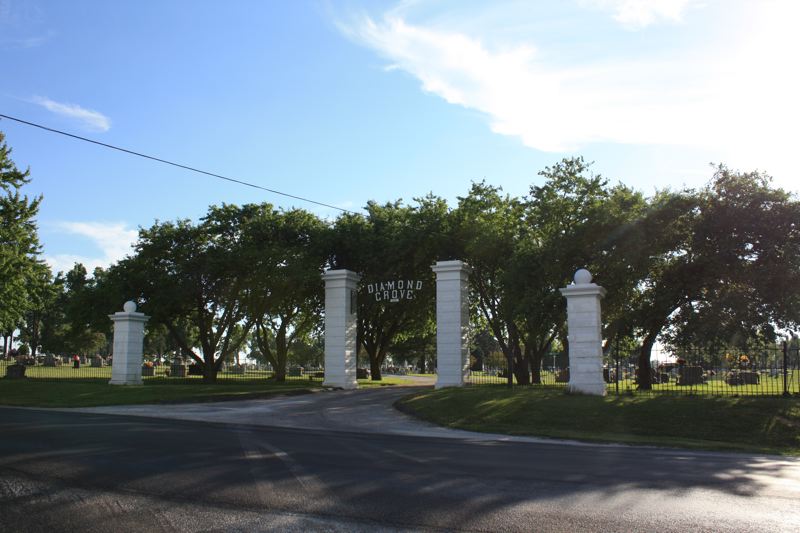
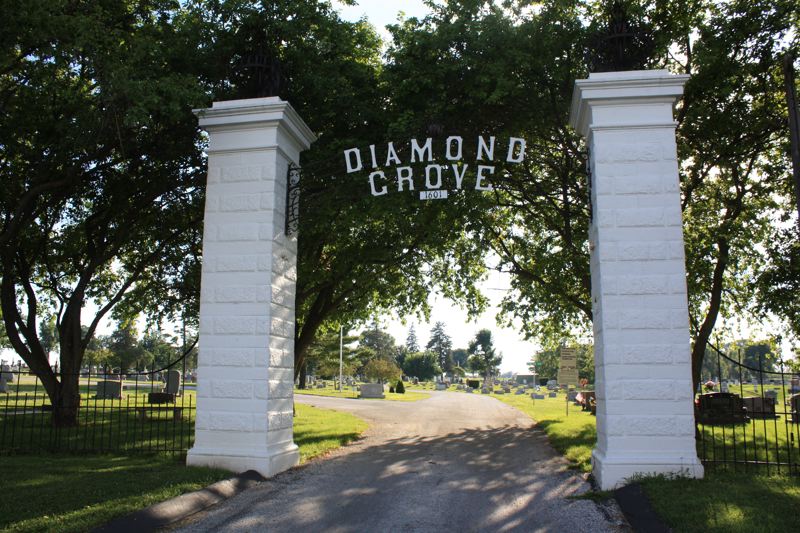
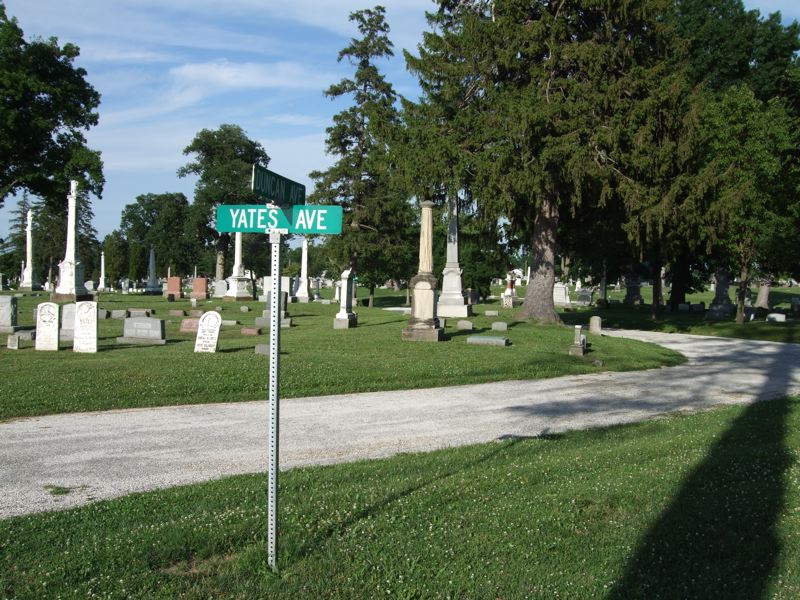
See The Henderson Plot Straight Ahead, Looking Just To The Right Of The Sign
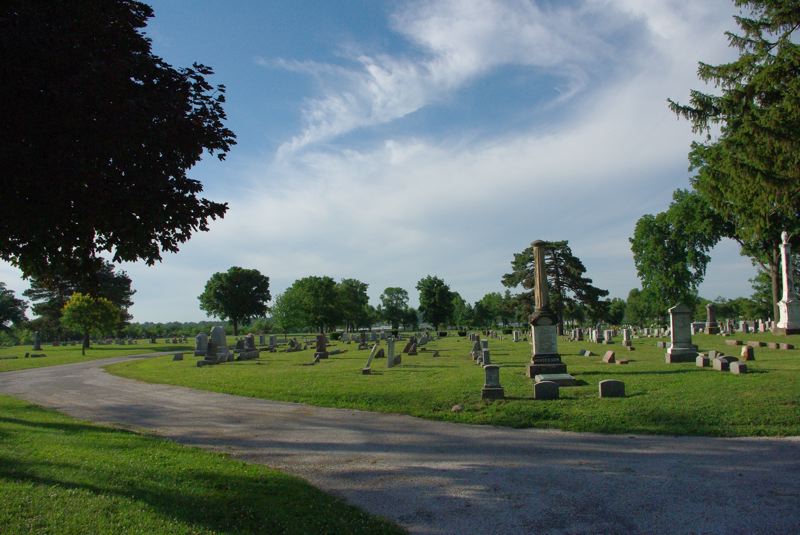
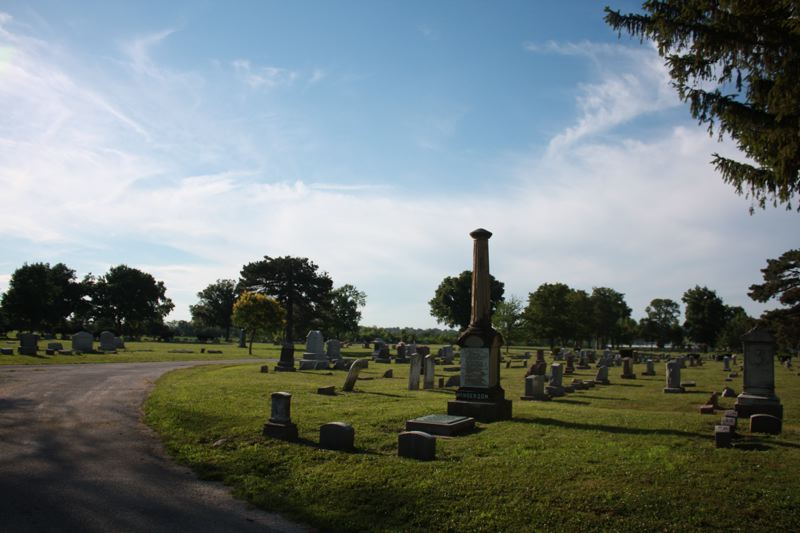
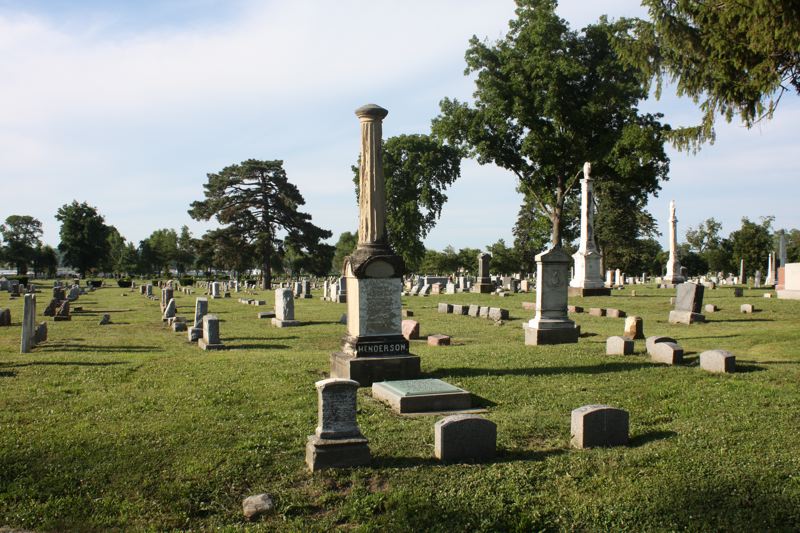
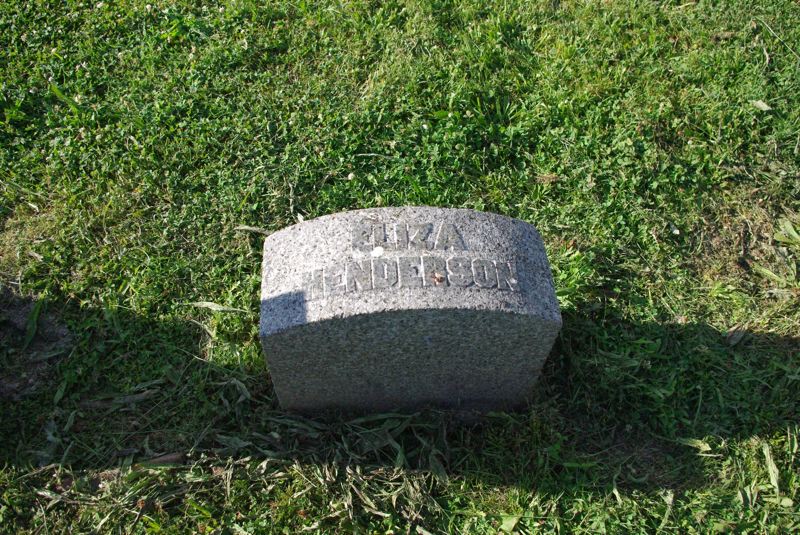
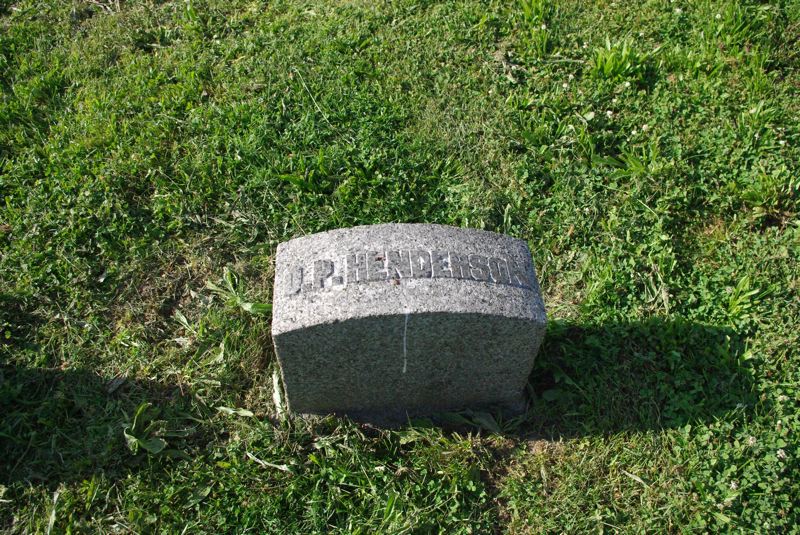
Special Thanks to C. Wayne Kilpatrick and Tom L. Childers for assisting in providing photos of the graves you see on this site. In June, 2009 your web editor along with the these fellows took a 3000 mile trip through Missouri, Illinois, Indiana, Kentucky and Tennessee. We located and photographed the graves of seventy-five preachers and church leaders during the week. It was a great week of fellowship, tiring, but most satisfying. When we got to Diamond Grove, it was close to the end of our second day of travels. We were very tired when we arrived, but then had to look for the grave. We walked in the hot evening sun for nearly an hour. In fact we were very close to giving up when one of us stumbled onto the grave. We would have hated to have missed it. If you are ever in the Jacksonville area, be sure to go by and visit the grave. As the photos tell, the weathering has taken its toll on the marker.
![]()
